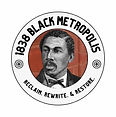In 1821 a group of single and widowed Black woman founded the Daughters of Africa
- 1838 Black Metropolis
- Jul 20, 2023
- 3 min read
Updated: Aug 12, 2023
You may have heard about beneficial societies. Starting with the Free Africa Society in the late 1770s, Black people in Philadelphia organized to support each other. These groups were popular; at least half of the adults in the 1838 Census belonged to a group.

When you belonged, you had to pay dues. But if you were sick you got sick benefits. If you died, they would take care of your burial. If you died and had children, they would develop an orphans fund for your kids.
You had to follow the rules though - or you might get kicked out.
Its important to think about how early these groups were; basically formed at the same time this country was formed. When you think of early America, think of Black organized power and solidarity represented by the beneficial societies.

Most of the societies in the Black Metropolis organized along gender lines. And one of them, the Daughters of Africa, has very good documentation at the Historical Society of Pennsylvania.
Here's the booklet they would give you when you joined. This is from 182. That is the year that Harriet Tubman was born - just to give you an idea of how long ago this was.
Courtesy Historical Society of Pennsylvania
Here's a page from their minute book from March, 24, 1829 where you can see they are collecting dues and giving dues out when members are in need. It reads, "Phillis Engnem - one week pay..$1.00"

Here's a situation where one of the members was kicked out for bad behavior. It reads: "The Committee brings a charge against Bethany Blanton for immoral conduct and theft."

Beneficial Societies helped newly arrived freedom seekers to find a group of people that could help them transition into a life of freedom. Perhaps this is why so many people joined the Beneficial Societies.
Here's a list of the Beneficial Societies from the 1838 Census to give you an idea of the scope and breadth of these groups. Note that there were 7448 people in these societies representing and building social foundation of The Black Metropolis.

W.E.B Dubois felt that Beneficial Societies were foundational to the growth of all other Black economic, social and political organizing. He created this chart in his book on Black Economic Cooperation way back in 1907.

I have circled the Beneficial Societies so you can see them on the chart. But this is a great chart to examine if you have more time. At the top you can see that he's indicating that insurrections by enslaved people was the foundational movement that led to Black emigration to the North, the growth of the Underground Railroad and eventually to Emancipation.
In the current climate where groups like Moms of Liberty are working to censor Black History, it's important for us to understand that Black people, whether enslaved or free, have always been at the forefront of our liberation; from creating unrelenting pressure through insurrections and uprising in the South, to building and maintaining conduits to freedom like the Underground Railroad, to creating spaces for stability and sanctuary in the North, like the Daughters of Africa.
For more on this see any book by Gerald Horne and Manisha Sinah's book The Slave's Cause.
Sources
Constitution and Bye Laws of the Beneficial Society of the Daughters of Africa. Philadelphia: Printed for the society, 1831. Courtesy the Historical Society of Pennsylvania.
Daughters of Africa--Minutes [Ams. 35] (1822-1838), Historical Society of Pennsylvania, Leon Gardiner Collection
Daughters of Africa--Order Book [Ams .351] (1821-1829). Historical Society of Pennsylvania, Leon Gardiner Collection
Du Bois, W. E. B. (William Edward Burghardt), 1868-1963, and Conference for the Study of the Negro Problems (12th : 1907 : Atlanta). Economic Co-operation Among Negro Americans: Report of a Social Study Made by Atlanta University Under the Patronage of the Carnegie Institution of Washington, D.C. Together With the Proceedings of the 12th Conference for the Study of the Negro Problems, Held At Atlanta University, On Tuesday, May the 28th, 1907. Atlanta, Ga.: The Atlanta University Press, 1907.






